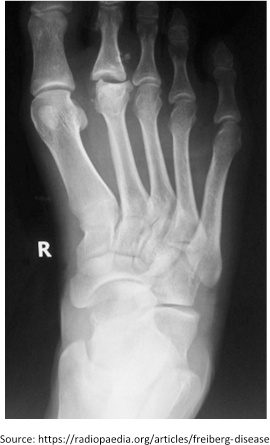Freiberg’s Infraction is an avascular necrosis of the metatarsal head, most commonly the second metatarsal head. This means that the bone at the head of the second metatarsal dies due to insufficient or interrupted blood supply. The second metatarsal is one of the long bones at the front of your foot and the head sits in the ball of your foot behind your second toe.
metatarsal dies due to insufficient or interrupted blood supply. The second metatarsal is one of the long bones at the front of your foot and the head sits in the ball of your foot behind your second toe.
There is debate surrounding the cause of Freiberg’s infraction but there are two main theories. The first is trauma, either one large traumatic event or repetitive micro-trauma which damages the growth plate which may also then damage the blood supply to the bone. The second is a vascular injury which compromises blood supply to the bone.
Regardless of the exact cause Freiberg’s infraction most commonly presents in women aged 11-17 years. Typical symptoms include a limp with significant pain in the ball of the foot and possibly localised to the head of the affected bone. The pain may only be present during or worsened by activity and there may be some stiffness. Other symptoms may include swelling, tenderness and callousing.
Because of the nature of the symptoms, Freiberg’s infarction may sometimes be confused with Morton’s neuroma, capsulitis, synovitis or a stress fracture.
Freiberg’s infraction results in collapse of the bone and cysts at the joint in the head. This leaves a flat rather than rounded head to the bone with a wider gap at the joint. The metatarsal head may also have fragments flake off and sclerosis occurring at the bone margins. These changes to the bone increase the likelihood of developing painful osteoarthritis at the joint later in life so it is important to seek management while the infraction is active to minimise damage to the joint and to help with symptomatic management
Treatment:
Stage 1: Immobilisation and physical therapy (until symptoms resolve)
– This will most likely involve a CAM walker (also known as a moonboot) for 4-6 weeks
– This can be complemented by therapeutic ultrasound, ice and NSAIDs such as ibuprofen
Stage 2: Gradual return to activity
– This will involve supporting the affected metatarsal and limiting movement at the affected joint to prevent further damage to the joint. This will likely involve custom orthotics with metatarsal padding and good quality footwear
– Shoes with high heels should be avoided in the future.
Stage 3: Managing osteoarthritis
– Osteoarthritis is a very likely outcome after having Freiberg’s infraction although it may not occur until a few to many years later.
– Further reduction in movement at the joint is ideal
– Panadol osteo, heat packs and other arthritis management strategies are indicated here.
Surgery
- Depending on changes that occur at the joint, a simple surgery may be advised early on to clean up any bone fragments and to preserve the joint as much as possible.
- The are other surgery options available as well to promote blood flow, reduce symptoms and to encourage blood vessel and fibrocartilage formation
- Arthroscopy is sometimes performed to try restore some range of motion at the joint
- Osteotomy (removal of a segment of bone) is sometimes advised in more severe cases.

Comments are closed.